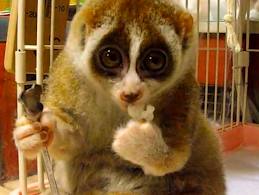 By Asier Gil Vasquez
By Asier Gil Vasquez
Our perceptions of the world will define our opinions, beliefs and actions. Traditional mass media and new forms of media, like online social media, are one of the strongest external agents in the process of building perceptions. The portrayal of animals and wildlife has provoked different perceptions and consequences. Media tends to modify the image of the animal de-contextualizing it in order to make it a cultural commodity.
Altered perceptions of wild animals have generated conservation conflicts such as pet crazes. Primates and many other mammals are generally represented on YouTube, the Internet video-sharing site, as companion animals, increasing the interest of users on purchasing one. This sort of portrayal in the media can aggravate and increase illegal wildlife traffic. Using the case of the slow loris (Nycticebus spp.) we can trace the process of promotion via social media, the de-contextualization of the wild animal and the promotion of negative attitudes such as the pet trade. These nocturnal prosimians became globally known when a first YouTube video of a pet individual became viral, earning millions of visits. Ever since, videos of pet slow lorises have generated a solid imagery of these animals on the internet, based on a portrayal that highlights the pet and cute status.
Comments made by users show the attitudes towards the content of these videos, with a high percentage of the audience remarking the “adorableness” or stating that they want to purchase one. These perceptions, globally spread, can have an effect on the conservation of wild populations, generally endangered due to the illegal trade. Equally, these videos have generated debates on the comments section about the domestication, conservation and biology of the slow loris, some of them mentioning conservation campaigns and organizations such as Little Fireface Project. Conservation organizations can use the same tools that made these animals popular in order to turn the tables and propagate new and more accurate portrayals of the animal, as well as conservation messages.
